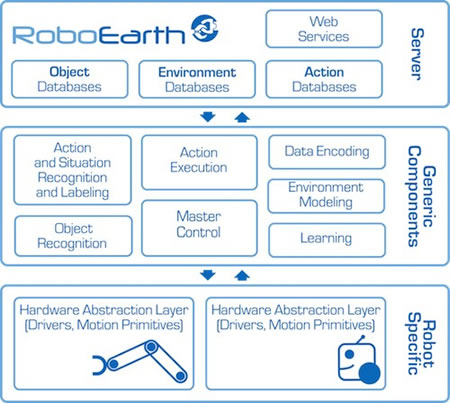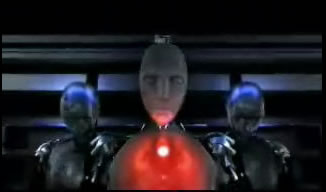Science Fiction
Dictionary
A B C D E F G H I J K L M N O P Q R S T U V W X Y Z
RoboEarth Lets Robots Learn From Each Other

RoboEarth, which is kind of like a Wikipedia for robots, was designed by European engineers to let robots learn from each other. Robots will be able to write to and read from a common information source. In this way, a robot that has never done a particular task can do it immediately once some other robot has done it.

(RoboEarth overview diagram)
Bringing a new meaning to the phrase "experience is the best teacher", the goal of RoboEarth is to allow robotic systems to benefit from the experience of other robots, paving the way for rapid advances in machine cognition and behaviour, and ultimately, for more subtle and sophisticated human-machine interaction.RoboEarth will include everything needed to close the loop from robot to RoboEarth to robot. The RoboEarth World-Wide-Web style database will be implemented on a Server with Internet and Intranet functionality. It stores information required for object recognition (e.g., images, object models), navigation (e.g., maps, world models), tasks (e.g., action recipes, manipulation strategies) and hosts intelligent services (e.g., image annotation, offline learning).
To close the loop, the RoboEarth Collaborators will also implement components for a ROS compatible, robot-unspecific, high-level operating system as well as components for robot-specific, low level controllers accessible via a Hardware Abstraction Layer.
(RoboEarth demonstration video)
This reminds me of the talk between robots (TBR) feature discussed by Frederik Pohl in his 1954 short story The Midas Plague. In the story, Henry is a companion robot; these robots cooperate with each other, sharing information to better server their masters:
"Fine! Well, get started on the other things, then.""Yes, sir," said Henry, and assumed the curious absent look of a robot talking on the TBR circuits - the Talk Between Robots radio - as it arranged the appointments for its master.
More recently, In the 2004 movie I, Robot, the advanced NS5 robots had a special feature: additional software and instructions could be downloaded wirelessly to individual robots. NS5's receiving a download show a red glow in the chest cavity.

(Middle NS5 Robot Gets A Download)
Humans keep on trying to help robots talk with each other:
- Bluetooth-Enabled Robot Legs Talk To Each Other
Each leg mimics the other, thanks to Bluetooth technology that sends signals over a short distance. - Robots Learn To Lie
The experimenters also gave the robots the ability to talk with each other. - Robots Taught Human Communication Secrets
Roboticists are letting robots learn all of the secret ways that human beings share information with each other.
Scroll down for more stories in the same category. (Story submitted 2/6/2011)
Follow this kind of news @Technovelgy.| Email | RSS | Blog It | Stumble | del.icio.us | Digg | Reddit |
Would
you like to contribute a story tip?
It's easy:
Get the URL of the story, and the related sf author, and add
it here.
Comment/Join discussion ( 8 )
Related News Stories - (" Robotics ")
Golf Ball Test Robot Wears Them Out
"The robot solemnly hit a ball against the wall, picked it up and teed it, hit it again, over and again...' - Frederik Poh, 1954.
PaXini Supersensitive Robot Fingers
'My fingers are not that sensitive...' - Ray Cummings, 1931.
Artificial Skin For Robots Is Coming Right Along
'... an elastic, tinted material that had all the feel and appearance of human flesh and epidermis.' - Harl Vincent (1934)
Robot Guard Dog On Duty
I might also be thinking of K-9 from Doctor Who.
Technovelgy (that's tech-novel-gee!) is devoted to the creative science inventions and ideas of sf authors. Look for the Invention Category that interests you, the Glossary, the Invention Timeline, or see what's New.
Science Fiction
Timeline
1600-1899
1900-1939
1940's 1950's
1960's 1970's
1980's 1990's
2000's 2010's
Current News
Golf Ball Test Robot Wears Them Out
"The robot solemnly hit a ball against the wall, picked it up and teed it, hit it again, over and again...'
Boring Company Vegas Loop Like Asimov Said
'There was a wall ahead... It was riddled with holes that were the mouths of tunnels.'
Rigid Metallic Clothing From Science Fiction To You
'...support the interior human structure against Jupiterís pull.'
Is The Seattle Ultrasonics C-200 A Heinlein Vibroblade?
'It ain't a vibroblade. It's steel. Messy.'
Roborock Saros Z70 Is A Robot Vacuum With An Arm
'Anything larger than a BB shot it picked up and placed in a tray...'
A Beautiful Visualization Of Compact Food
'The German chemists have discovered how to supply the needed elements in compact, undiluted form...'
Bone-Building Drug Evenity Approved
'Compounds devised by the biochemists for the rapid building of bone...'
Secret Kill Switch Found In Yutong Buses
'The car faltered as the external command came to brake...'
Inmotion Electric Unicycle In Combat
'It is about the size and shape of a kitchen stool, gyro-stabilized...'
Grok Scores Best In Psychological Tests
'Try to find out how he ticks...'
PaXini Supersensitive Robot Fingers
'My fingers are not that sensitive...'
Congress Considers Automatic Emergency Braking, One Hundred Years Too Late
'The greatest problem of all was the elimination of the human element of braking together with its inevitable time lag.'
The Desert Ship Sailed In Imagination
'Across the ancient sea floor a dozen tall, blue-sailed Martian sand ships floated, like blue smoke.'
The Zapata Air Scooter Would Be Great In A Science Fiction Story
'Betty's slapdash style.'
Thermostabilized Wet Meat Product (NASA Prototype)
There are no orbiting Michelin stars. Yet.
Could Crystal Batteries Generate Power For Centuries?
'Power could be compressed thus into an inch-square cube of what looked like blue-white ice'
